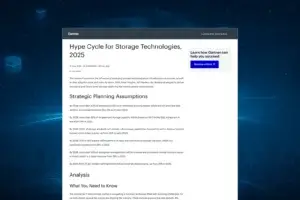Data is the lifeblood of business. In the information technology industry, data storage is crucial for preserving digital information and keeping it secure for future needs. Inadequate data storage can result in losses of important material and negatively impact an organization and its reputation.
Data storage, especially non-database unstructured data such as document files, images and videos, is growing rapidly and stressing storage infrastructure in many organizations.
By choosing the correct storage solution for your business, you can help make sure your data stays safe, protected, and easily accessible. In this introductory guide from Peer Software, we discuss the three main types of data storage: file, object, and block storage and their differences and advantages.
File Storage: Managing Data in Hierarchies
File storage is a type of data storage that is also referred to as file-level or file-based storage. It manages data using hierarchies and stores it on a network-attached storage (NAS) device or computer hard drive. The data hierarchy goes like this:
- The data is stored in files
- The files are organized in folders
- The folders are organized under directories and subdirectories
When a user wants to locate a file, they just need to follow the hierarchical path from directory to subdirectory to folder to file. The hierarchies can be shared across networks, so multiple people on a team can access the files. File storage is best suited for storing documents or media files that benefit from being organized in a structured manner.
Organizations typically choose file storage because it supports file sharing, updates can be made in-place and it utilizes common CIFS and NFS protocols.
File storage vendors have advanced their offerings as data has continued to grow, with many vendors offering both on-premises as well as cloud based file storage offerings.
Object Storage: A Scalable Approach
Object storage is a type of data storage best suited for relatively static, non-transactional data organized into units called objects. Every object includes data, metadata, and a unique ID number for accessing the object easily. Rather than using a hierarchy, the objects are stored in a structurally flat data environment.
It is ideal for storing digital communications like emails, videos, image files, web pages and more. Objects can be stored on-site or accessed from anywhere when they are on cloud servers. However, dynamic data is not well-suited for use with object storage because the entire object would have to be rewritten to modify it.
Object storage offers unlimited scalability vs. traditional file storage. It’s typically a less costly option for storing large volumes of data than block and file storage and has become increasingly popular for backup and archiving use cases as it is resistant to ransomware thanks to its immutable characteristics.
As object storage is utilized for rapidly growing volumes of data, it is commonly used for AI and machine learning applications that require access to large amounts of data.
Block Storage: Transactional High Performance
Block storage is another form of data storage that often houses data on storage area networks (SANs). It takes any form of data and separates it into equal-sized blocks. The blocks are then stored separately under a unique address, designed for fast retrieval. When an application wants to access a file, the system uses the unique address to pull the blocks back together and form the file. This method is faster and more efficient than navigating through a hierarchy like with file storage.
Block storage only uses limited metadata so the data can be retrieved quickly, which is often required for high-performance jobs. This is why block storage is used for transactional databases, virtual machines, and other critical business applications that need to be accessed swiftly.
Block storage uses space more efficiently than file storage because its limited metadata takes up less room on storage devices. It’s also easy to scale to meet growing capacity needs. However, it can be more costly than object storage because of its efficiency and scalability benefits.
Scalability vs. Performance
Scalability refers to the ability of the data to be changed in size or scale. An organization’s data storage needs to be scalable to ensure that its future requirements can be accommodated.
If data storage isn’t scalable enough, businesses often must add more capacity which can be costly. The three main data storage types and their scalability are as follows:
Object storage offers nearly unlimited scalability, but works at a slower pace for transactional data
- File storage is scalable, but has constraints with large datasets and concurrency
- Block storage is easily scalable by adding or expanding storage volumes, but can be limited by the system
- Object storage offers nearly unlimited scalability, but works at a slower pace for transactional data
Comparing Use Cases and Advantages
When it comes to choosing the right type of data storage for your company, it’s important to consider a few factors. Companies need to look at their type of business, their budget, and their needs for:
- Data scalability
- Data security and redundancy
- Data accessibility
- Data backup and recovery
If a business needs large volumes of data stored and the data is relatively static, object storage is the best option. This includes archiving files and backup/disaster recovery as object storage systems favor the quantity of the storage over the accessibility of it. However, if a company needs quick file retrieval with a transaction-heavy workload, object storage is not the best choice.
If a company’s focus is data storage for file sharing and collaboration, file storage is the best option. File storage lets multiple users access files at the same time and is easily accessible.
If a business is looking for high-performance storage that has low latency, block storage is the best choice. Block storage offers fast access to stored data and is suitable for workloads that depend on fast retrieval. At the same time, it’s not the best choice for businesses that have a low budget because it’s more expensive than other options.
Benefit from a Modern Distributed File System
By utilizing an Active-Active data services fabric with real-time replication across multi-platform edge, data center and cloud storage, Peer Global File Service (PeerGFS) helps customers increase productivity with local access to data, high availability and data resiliency, and provides continuous data protection with near-zero RPO and RTO.
Request a trial of PeerGFS today to see how it can help your business or contact our team for more information.







